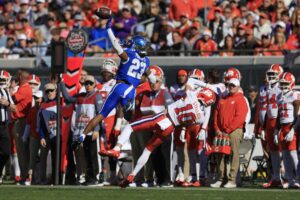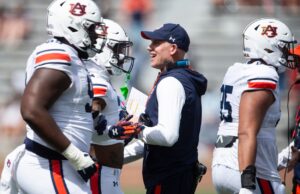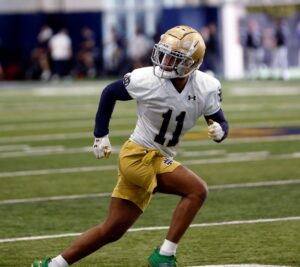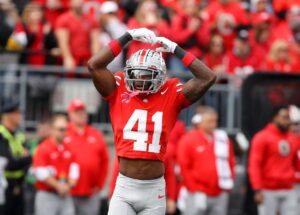Monday, California did what California does. It passed a law that has befuddled the masses across the country. Senate Bill 206 was authored by state senator Nancy Skinner from Berkley. It passed the CA legislature 82-0 in September. That alone is unheard of in CA politics. Monday the state announced that Governor Gavin Newsom signed it into law. Also typical of California, it has created a larger fight. This one is the state of California Versus The NCAA.
California Versus The NCAA
Now comes the tricky part. Explaining to America what the bill is, and what it is not. Let’s start with the basics. CA Senate Bill 206 says that beginning in 2023, college athletes in California will own the rights to their imaging and branding. What it is not is a pay-to-play bill. Actually, South Carolina and New York have proposals going through the process that does that.

The bill, signed by Newsom on Friday, is simple. Every person reading this article owns the right to their image. If someone wants to use a picture or image of someone for profit, they must first seek permission, and in all likelihood pay for the rights to the image. In other words, “Joe Smith” owns the rights to his image. Want to use it? Get his permission and pay him. That is as long as “Joe Smith” is not a college athlete, who has to live under the decree of the NCAA. If that is the case you are free to take his image, use it as you want, make money off it and pay him nothing. The NCAA, the governing body for college athletics, says players cannot profit off their images or likeness. They cannot make money from the people making off them.
NCAA Issues Empty Threats
The NCAA had threatened to ban California schools for competing for national championships if this bill passed. It said the athletes who took advantage of their newfound freedom, the same ones you and I already enjoy, would no longer be eligible under amateurism standards. Therefore, athletes from the schools and the schools themselves could not compete for NCAA championships. The premise, of course, is absurd. Stanford, UCLA, and USC, in that order, have the most NCAA championships in the country. The three of them combined have more than 300 sanctioned titles. That is more than any of the other conferences in the nation in their entirety. The idea that they, along with Cal or any other California school, would be banned from the national titles is laughable.
But the threat worked. The Pac 12 Conference, the most poorly managed major college conference in the country spoke out against the legislation prior to the voting process. They were actually concerned that the NCAA would come through on its fracturable threat. Not only did the Pac 12 speak out as a conference, but many of the conference’s schools, including all the ones in California, were also opposed.
In pathetically typical self-serving style, the schools were not opposed because they did not want their scholar-athletes to take advantage of the newfound leniencies. They took the contrapositive position based on their own finances. They contended that it would require a whole new level of rules enforcement and more staffing. Thus it would cost them to make sure everyone was compliant with the new law. Of course, if you are going to object, we are going to need to view the “why” and it is clear this is a financial bemoaning on your part.
Reality Versus Perception
Student-athletes will now be allowed to have an agent to negotiate these sponsored deals for them. The agents must be licensed in the state of California. The bill prohibits any revocation of their scholarship for being paid for the use of their likeness. The bill also bars the NCAA from banning schools from postseason competition. It was California’s way of saying, “You come at us, we come back on you, NCAA.”
In the debate over the last month, and certainly in much of the national coverage, clarity has been as lacking as money for the student-athletes. Schools are still prohibited from paying the athletes for their performances. This runs contrary to the pundits claiming this is the end of collegiate athletics. They would do well to read more and talk less.
NCAA Claims Level Playing Field; America Scoffs
The NCAA, in its protestations, said this would undo the “balance of the level playing field.” It assumes recruits would now beat a path towards California schools so that they can get paid. The fact that the NCAA wants to pretend that there is a level playing field throughout the country is as preposterous as letting Nick Saban make money of his likeness in an insurance commercial, but not the players who actually put their bodies at risk every week for him. The schools with the biggest budgets, most over-the-top locker rooms, bigger stadiums, and shiniest facilities get the best recruits. There have been 97 5-star high school football recruits over the last three years. Five colleges have signed 55 of them, (four of the schools are in the south, and the other is in the Midwest). Where is the balance and level playing field?
But now, if a local business in Santa Cruz, CA wants to use the top swimmer at UC Santa Cruz in a local ad, they can seek the permission of that athlete, get a contract, and pay the person. This is not exclusive to bigger programs, like the booster money. Even athletes at smaller schools can take advantage of it. And please don’t tell us the athletes get paid via full-ride scholarships; not while coaches like Saban on a national level get an institution-paid $8.7 million this year with no restrictions on outside income. And not while schools sell jerseys with the name and number of their top players, but the athlete gets nothing out of it.
The Origins
Much of this is fallout from the Ed O’Bannon lawsuit. He filed an anti-trust lawsuit against the NCAA and others in 2009. He saw an exact likeness of himself in an EA Sports video game. The NCAA had a licensing agreement with the video game manufacturer. There was the #31, with a UCLA jersey, bad head, left-handed shot, and exact likeness to the Bruins hall-of-famer. EA Sports got paid. The NCAA got paid. O’Bannon, as an NCAA athlete, was left out of the windfall. In 2014, a District Court judge ruled that the NCAA and EA Sports were guilty of restraint of trade. O’Bannon’s victory was upheld throughout the appeals process.

The new California law gets ahead of the same scenario. It says, let’s acknowledge that some players have a market value off the field. We know this to be true. The schools sell jerseys and use their likeness to market the sport and to sell tickets. So, if someone outside the university holds the athlete in the same appraisal light, let them conduct business. After all, scholarship music majors are allowed to perform shows, have their likenesses used, and get paid. And the school is not making the millions off them that they are off the athletes. Why can’t the athletes have the same ownership of their likeness as you and I do?
The End Is The Not The Conclusion
What’s next is obvious. Court proceedings. There are four years before the bill takes effect. There will be legal challenges. Meanwhile, other states will create similar legislation. The NCAA would be wise to meet the states “halfway.” They can come up with rules that can be adopted, enhanced, and enforced at schools throughout the country. It at least would be a real step towards a balanced and level playing field that includes the people generating the revenue.






